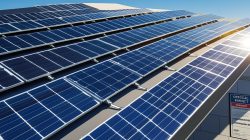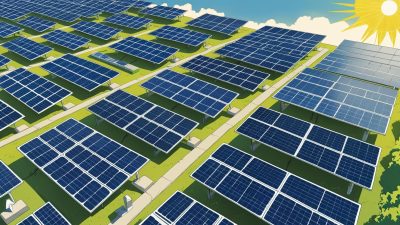Solar Farm Impact on Agriculture in Australia
Bloggerbanyumas.com – As Australia continues to pursue its ambitious renewable energy goals, solar farms have become a central part of the country’s clean energy transition. The rise of large-scale solar installations across rural and regional areas raises important questions about their impact on agriculture. This article will examine the economic, environmental, and operational consequences of solar farms on agricultural practices in Australia in 2025, highlighting the interplay between renewable energy and food production.

Australia’s rural landscape is increasingly being transformed by solar farm developments, offering both new opportunities and challenges for the agricultural sector. Solar farms occupy large tracts of land, traditionally used for farming and grazing, which raises concerns about land use, water resources, and the long-term viability of farming operations. However, solar farming also presents a significant opportunity for agricultural diversification, improved land use efficiency, and sustainable practices.
In this article, we will explore how the growth of solar farms affects Australian agriculture, considering both positive and negative outcomes. We will also discuss strategies that can help mitigate potential challenges and enhance the synergy between solar energy and agricultural production.
Solar Farms and Land Use: Competing Interests or Symbiotic Relationships?
Dual Land Use: Combining Solar Power and Agriculture
One of the most significant advantages of solar farms in rural Australia is the potential for dual land use. Dual-use or “agrivoltaics” refers to the practice of integrating solar power generation with agricultural activities on the same land. In this scenario, crops or livestock can continue to be farmed while solar panels are installed, offering a unique opportunity to maximize the productivity of land that might otherwise be reserved solely for farming.
Agrivoltaics has gained traction in Australia as a way to balance the country’s renewable energy targets with the needs of the agricultural sector. Solar panels, installed above ground level, provide shade that can protect crops from heat stress, while still allowing for farming underneath. For example, growing shade-tolerant crops such as leafy greens or certain fruits could become more viable in areas with high temperatures. Additionally, grazing livestock can roam underneath solar arrays, benefiting from the cooler microclimates created by the panels.
This approach helps farmers maintain agricultural production, while simultaneously contributing to renewable energy generation, thus supporting Australia’s transition to a low-carbon economy. However, effective implementation of agrivoltaics requires careful planning, including considerations around panel placement, crop selection, and land management practices.
Land Use Conflicts: Agricultural Land Conversion for Solar Farms
While dual land use offers benefits, the large-scale conversion of agricultural land to solar farms is an issue that cannot be overlooked. As solar farms expand in Australia, agricultural producers face challenges from the displacement of valuable farmland. In some cases, fertile agricultural land is being repurposed for solar energy, particularly in regions with high solar potential.
The conversion of prime agricultural land for solar farm development can lead to the loss of food production capacity, with significant implications for local and national food security. This issue is especially concerning for crop farmers who rely on the land’s fertility for growing high-value products. For example, regions that specialize in high-demand crops such as fruits, vegetables, and grains could be negatively affected by the transition to solar farming.
Moreover, the scale of land required for solar farms means that large swathes of land are often cleared of vegetation and irrigation infrastructure, potentially impacting local ecosystems and biodiversity. While solar farms typically have a lower environmental footprint compared to traditional fossil fuel-based energy infrastructure, the environmental consequences of land use change cannot be ignored.
Managing Land Use Conflicts: Regulatory Measures and Incentives
To address concerns regarding land conversion, policymakers in Australia are considering regulations and incentives aimed at promoting responsible land use for solar farm development. These measures could include zoning restrictions that prioritize non-arable or marginal land for solar projects. Additionally, governments may implement incentive programs that encourage the use of dual land use practices, ensuring that agricultural operations can continue alongside renewable energy production.
Local councils and landowners also play a critical role in ensuring that solar farm developments are strategically located in areas with minimal disruption to agricultural production. By identifying land that is less suited to intensive farming or by promoting mixed-use areas, it is possible to maintain a balance between renewable energy development and agricultural sustainability.
Water Use and Agricultural Resources: Balancing Competing Demands
Solar Farms and Water Efficiency
Water resources are an essential component of agriculture, especially in water-scarce regions like much of rural Australia. The construction and operation of solar farms raise questions about their impact on water consumption, as irrigation practices are crucial for crop production in many parts of the country. Unlike traditional coal or gas power plants, solar farms do not require significant amounts of water for cooling purposes. However, some solar projects, particularly those using concentrated solar power (CSP) technology, may use water for steam production.
The water requirements for solar power generation are significantly lower than those of other forms of electricity generation, such as thermal power stations. This makes solar energy a more water-efficient alternative, especially in areas where water is already in short supply. As the solar industry expands, it is important to ensure that solar farms do not exacerbate existing water scarcity issues.
Water Use for Agricultural Production: Competition and Cooperation
The development of solar farms in agricultural areas raises concerns about the competition for water resources. In regions with already limited water availability, the installation of large solar arrays could strain local water supplies if not managed properly. Agricultural producers who rely on irrigation for their crops may find themselves competing with solar farms for access to water, particularly in dry years when water is in short supply.
However, there is an opportunity to mitigate these concerns by integrating water-saving technologies and strategies into solar farm operations. For example, rainwater harvesting systems can be incorporated into solar farm designs, capturing and storing water for later use in irrigation or livestock watering. Additionally, solar farms could be sited in areas where water demand for agricultural use is lower, reducing the competition for this vital resource.
By considering water management in both the solar and agricultural sectors, Australia can ensure that its renewable energy goals do not come at the expense of its agricultural production capabilities. Cooperative water management strategies can help balance the needs of both industries, ensuring that solar farms and agriculture can coexist sustainably.
Economic Impact on Agriculture: New Opportunities and Financial Viability
Economic Benefits of Solar Farms for Rural Communities
The rise of solar farms in rural and regional areas of Australia offers a range of economic benefits for local communities. By providing a new source of income for landowners, solar farms can help support farmers who may be struggling with low commodity prices or poor crop yields. Leasing land to solar companies can generate long-term, stable revenue streams for farmers, allowing them to diversify their income sources and reduce reliance on traditional farming practices.
In some regions, solar farms can create new job opportunities, both directly within the solar industry and indirectly through related sectors such as construction, maintenance, and supply chain logistics. These job opportunities can provide much-needed employment in rural areas, contributing to the economic development of regional Australia.
Additionally, the economic benefits of solar farms extend beyond the immediate vicinity. Increased renewable energy generation can lead to lower electricity prices for consumers, benefiting both urban and rural households. Moreover, the broader economic transition to renewable energy can help Australia secure its energy future, reducing the country’s dependence on fossil fuels and enhancing its energy security.
Economic Risks and Challenges for Agriculture
While solar farms offer economic opportunities, they also pose risks to agricultural livelihoods. The displacement of agricultural land for solar farms could lead to a loss of farming jobs and reduce the availability of locally grown food. Furthermore, the financial viability of farming operations may be compromised if land leases for solar farms replace productive agricultural land or if water resources become strained.
Farmers may also face increased competition for skilled labor and resources as the renewable energy sector grows. For example, the demand for workers in the solar energy industry may draw skilled labor away from agriculture, potentially leading to labor shortages in the farming sector.
To mitigate these risks, it is essential to support farmers in transitioning to sustainable agricultural practices and renewable energy integration. Initiatives such as providing training and support for agrivoltaics and creating market incentives for sustainable practices can help ensure that agriculture remains a viable and competitive industry in Australia’s renewable energy landscape.
The Future of Solar Farms and Agriculture in Australia
The impact of solar farms on agriculture in Australia is complex, with both positive and negative outcomes. As Australia continues its shift towards renewable energy, it is crucial to manage the interplay between solar power development and agricultural production. By embracing innovative land use practices, water management strategies, and economic incentives, Australia can create a future where solar farms and agriculture work together in harmony.
In 2025, the role of solar energy in Australia’s energy mix will continue to grow, and with it, the potential for solar farms to positively impact rural communities and agricultural operations. However, careful planning, collaboration, and policy development are essential to ensure that both industries can thrive together, providing sustainable energy solutions without compromising food production or rural livelihoods.
The future of agriculture and solar farms in Australia lies in finding innovative ways to integrate renewable energy with agricultural practices, ensuring a balanced and resilient future for both sectors. Through continued innovation and sustainable development, solar energy can become a driving force for economic growth and environmental stewardship in rural Australia.












